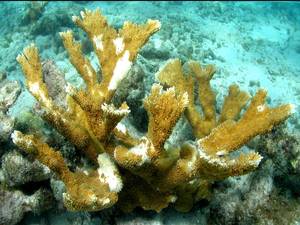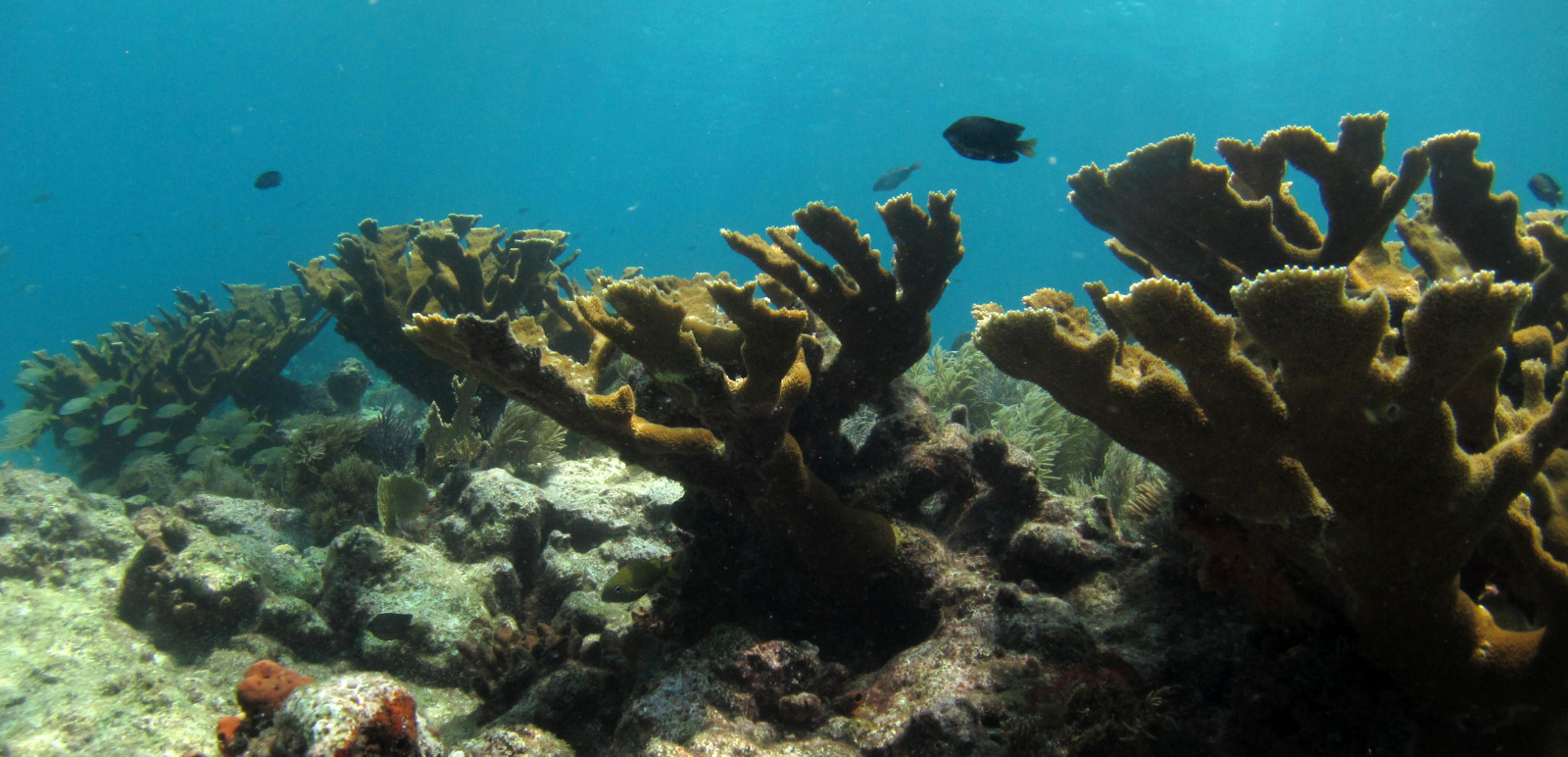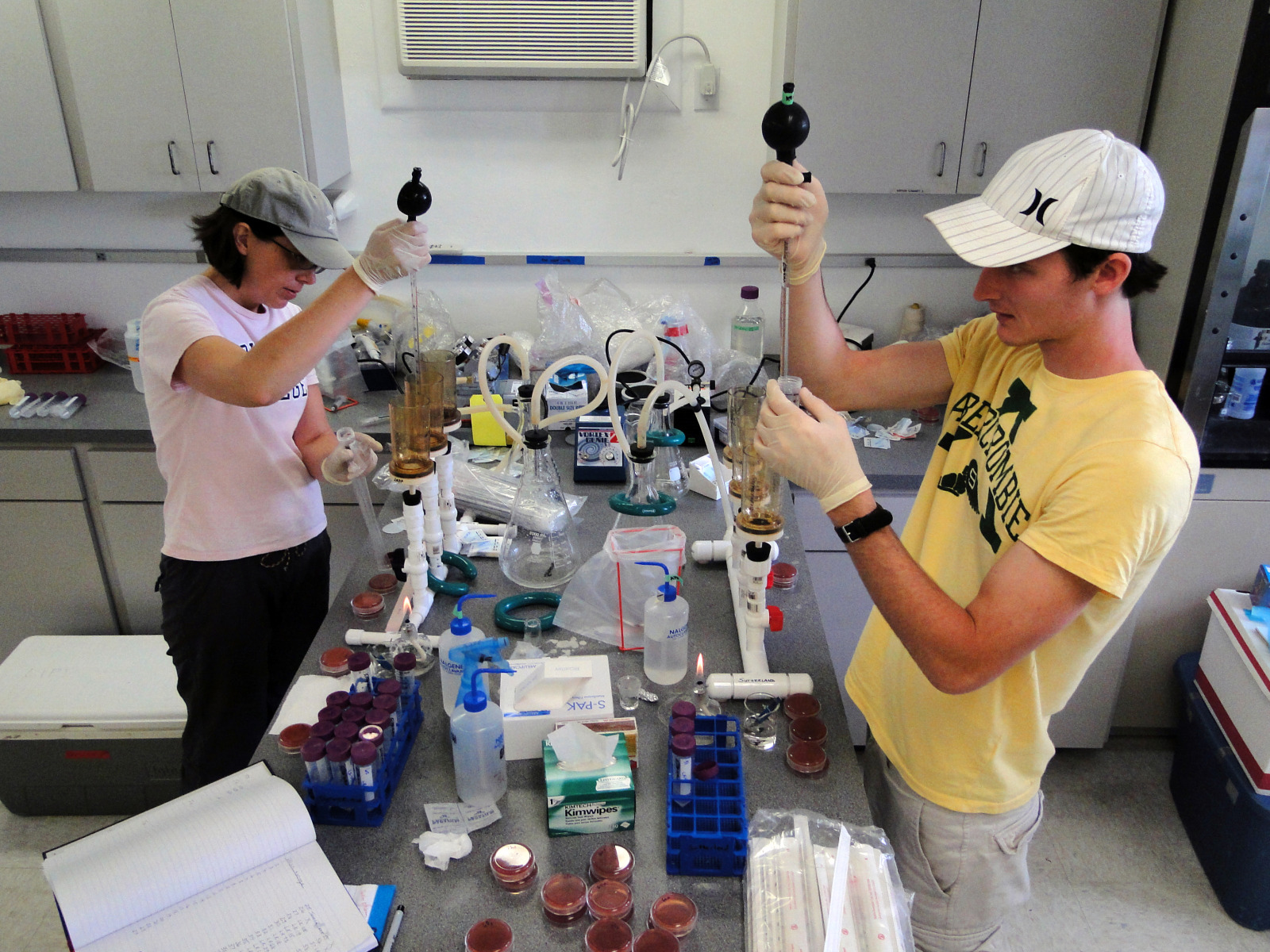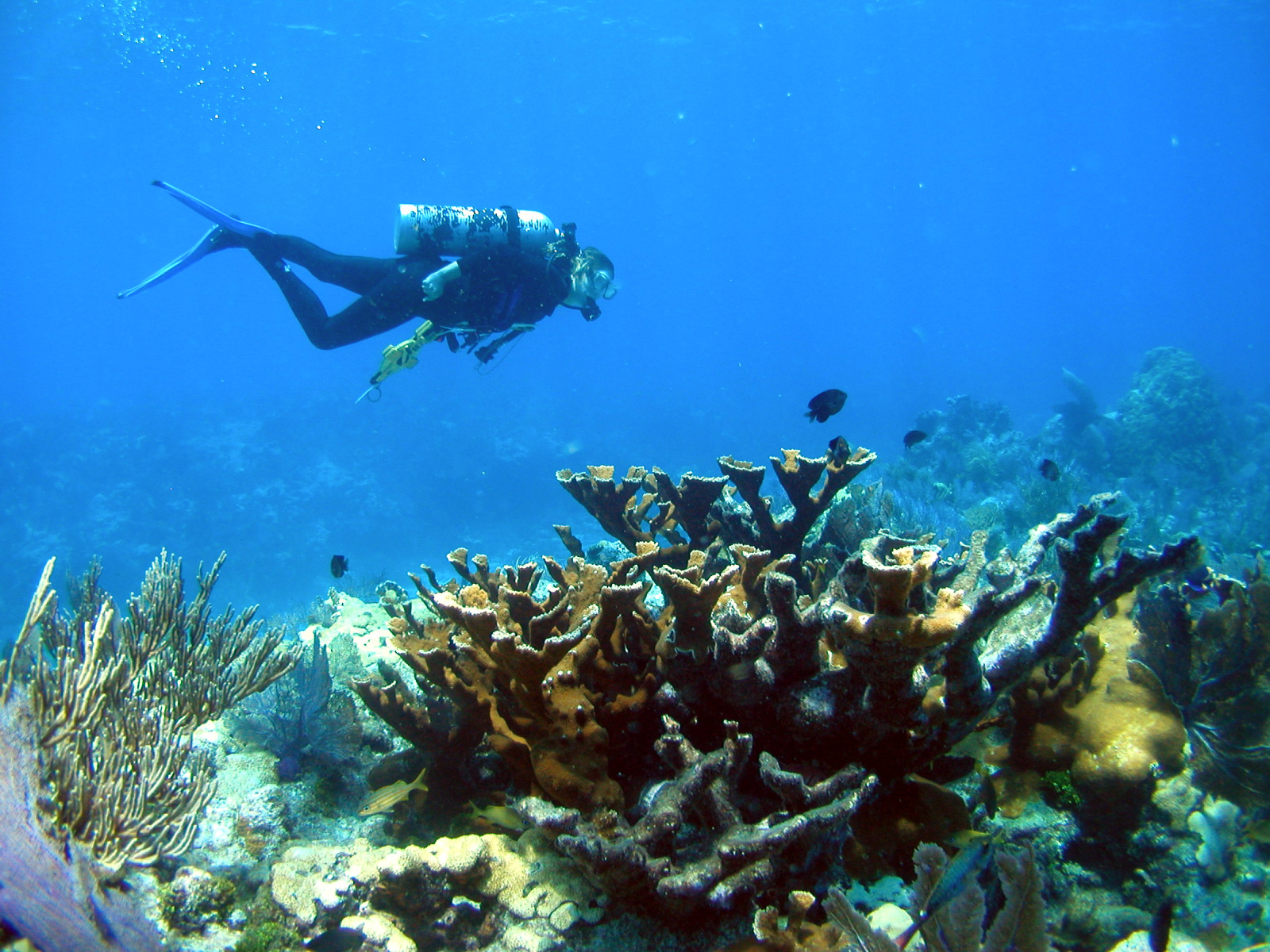Corals catch disease from human sewage
Interview with
Across the globe there are known to be around twenty types of disease that affect coral reefs.
Kathryn - Coral diseases are a major stressor affecting coral reefs today.
Helen - That's Kathryn Sutherland from Rollins College in Florida, a microbiologist and ecologist who specialises in coral diseases.
 Kathryn - Since the mid 1990s we've seen & described an increasing number of coral diseases. And they are in combination with other stressors that affect coral reefs. Coral reefs are threatened by warming seawater temperatures and poor water quality and increasing population densities especially along coastlines, and climate change - all of these combine and lead to the decline of coral reefs
Kathryn - Since the mid 1990s we've seen & described an increasing number of coral diseases. And they are in combination with other stressors that affect coral reefs. Coral reefs are threatened by warming seawater temperatures and poor water quality and increasing population densities especially along coastlines, and climate change - all of these combine and lead to the decline of coral reefs
Helen - One particular disease that's having a devastating impact on corals in the Caribbean is called White Pox disease. It only affects Acropora palmata, otherwise known as elkhorn coral because it grows into large antler-like structures. The disease gets its name from the white blotchy patches left behind when areas of diseased coral tissue die off, and for elkhorn coral this has spelt very bad news indeed
Kathryn - Elkhorn coral was once the most common coral in the Caribbean. But in 2006 it was listed as a threatened species under the US Endangered Species Act. And white pox disease played a major role in the listing. Since the discovery of white pox disease in the mid 1990s, elkhorn coral has decline and average of 90% in the Florida Keys. And this decimation is occurring in combination with white pox disease and other disease and other stressors and these other stressors include elevated sea water temperatures, poor water quality and other diseases like white band that have led to the decimation of elkhorn populations Caribbean-wide '
Helen - Back when white pox first started spreading around the Caribbean, the cause of the disease was a complete mystery. And Kathryn Sutherland took on the task of figuring out what was going on.
Kathryn - We had no idea what was causing this new, emerging coral disease. And so I approached it from a viewpoint of it could be anything. It could be bacteria, it could be a virus, it could be a protist, it could be a fungus. And so I started my search and originally I actually thought it might be a virus because white pox disease only affects one species of coral as far as we know and viruses are known to be very host specific.
 Helen - The focus for disease research in corals is the layer of sticky mucous that the coral polyps secrete onto their surfaces and Kathryn started out by investigating the bacteria that live in that surface layer.
Helen - The focus for disease research in corals is the layer of sticky mucous that the coral polyps secrete onto their surfaces and Kathryn started out by investigating the bacteria that live in that surface layer.
Kathryn - The mucous layer of a coral is the first line of defense of a coral against disease. And the mucous layer is full of microbes, whether or not the coral is healthy or diseased. And when we're looking for a disease pathogen we sample this mucous layer using non-destructive techniques, using a sterile needleless syringe, then we plate that mucous onto bacterial medias. And we can look for bacteria - we're going to find a lot because the microbes in healthy and diseased corals.
And for case for white pox I plated all the microbes that I found, plated them to pure culture and then I compared those that were found only in diseased individuals to those found in healthy individuals. And I had some potential culprits for pathogens for those that were clustering with the disease samples only. And then the next steps was to inoculate healthy elkhorn coral in a controlled seawater aquaria setting, so you're not affecting the population outside on the reef, and to see if those pathogens cause disease. And it turned out that the cause of white pox disease was indeed a bacterium.
And when we first discovered the pathogen that causes white pox disease in 2002, we knew that the bacteria that causes the disease, it's called Serratia marcescens, we knew that this bacteria was common in terrestrial environments, and in human guts and human sewage. But at that time we could only speculate that human sewage might indeed by the source of this pathogen that's killing corals because the pathogen, the bacterium, is actually found in the waste of other animals as well.
Helen - So, the next big question is where is this disease-causing bacteria, Serratia marcescens coming from? To work that out, Kathryn turned to genetic studies.
Kathryn - Once I'd identified the pathogen as Serratia marcescens in 2002 and wasn't certain where it was coming from, I did a widespread source survey looking at multiple potential sources in the Florida Keys. IN ordered to do this I collected human samples from the Key West wastewater treatment plant as well as waste samples from other animals like Key deer and sea birds. And I plated these samples on microbial media that was specific to the coral pathogen, Serratia marcescens.
And while I found Serratia marcescens in multiple animals, including key deer and sea guls, my genetic analyses showed that only the strain from human sewage matched the strain that was found in diseased corals on the reef. And so this gave me a genetic connection between the contamination of nearshore waters with sewage and the white pox disease of corals.
And then in order to indeed show that that strain of the pathogen from humans was causing the disease I inoculated healthy fragments again, like my original studies, with this strain that I found in human sewage and diseased elkhorn coral to see if it would be pathogenic. And indeed it was. The strain causes the disease in elkhorn coral in 5 days. So that gave us definitive evidence that humans and human sewage are the source of the pathogen that causes the devastating disease of corals known as white pox.
Helen - Kathryn and her team had traced the source of white pox disease back to  human sewage and the bacteria that live in our guts [what the bug does in us] It was the first time a disease has been found to jump from humans to a marine invertebrate:
human sewage and the bacteria that live in our guts [what the bug does in us] It was the first time a disease has been found to jump from humans to a marine invertebrate:
Kathryn - This is a different disease pathway than what we traditionally hear about human and wildlife, usually it's going from wildlife to humans. And example of a wildlife to human disease transmission model is swine flu or bird flu or HIV. But the movement of a disease-causing microbe from a human to a marine invertebrate had never been shown before.
Helen - And it's not just the bacteria in waste water that can cause problems for corals but the also nutrients - largely nitrates - that come with sewage.
Kathryn - When we add nutrients to the seawater where we find coral reefs we have algae blooms and macroalgae growth that outcompete corals for space on the reef and limit their ability to photosynthesise when we have we have algal growth in the water column"
Helen - Now that the cause of the disease has been identified, steps are being taken to combat the problem at the source.
Kathryn - We have bad news that humans are the source of the pathogen but the good news is that we have a solution. And the solution is actually already underway in the Florida Keys. And the solution is advanced waste water treatment. Historically in the Florida Keys they've utilised septic systems to contain human waste and the problem is that septic systems were not designed for areas like the Florida Keys.
These waste disposal systems were designed for rural areas with low population densities and areas with soil. Soil filters any contaminates that leak from a faulty septic system. But the Florida Keys are a high population density area with no soil and there's limestone bedrock instead. And this bedrock is porous and it allows human waste leaking from a faulty septic tank to quickly reach the groundwater and the nearshore environment.
A decade ago the city of Key West upgraded their sewage treatment from septic systems to advanced waste water treatment. And today the entire Florida Keys is the process of upgrading local waste water treatment and these measures will eliminate a source of the bacterium to the marine environment"
 Helen - Well, white pox disease isn't just a problem in Florida but across the Caribbean where there the widespread lack of good waste water treatment means that reefs continue to be vulnerable to a human source of the disease. Another question is whether this same bacteria, that is common across the world, is causing problems for marine organisms beyond the western Atlantic.
Helen - Well, white pox disease isn't just a problem in Florida but across the Caribbean where there the widespread lack of good waste water treatment means that reefs continue to be vulnerable to a human source of the disease. Another question is whether this same bacteria, that is common across the world, is causing problems for marine organisms beyond the western Atlantic.
Kathryn - Serratia marcescens could be affecting corals elsewhere in the world or other microbes that are associated with human sewage. We've described approximately 20 coral diseases and we only know the causes of approximately five. So there's a lot of unknowns out there. And so Serratia marcescens may be affecting other corals and causing other disease signs, signs that look different from white pox and on different coral species.
Helen- With funding from the National Science Foundation Ecology of Infections Disease programme, Kathryn is collaborating on a 5-year study jointly with Rollins College and the University of Georgia to understand how the pathogen infects corals and what drives outbreaks of the disease on reefs - could it be factors like climate change and warming seas?
Kathryn - One thing we're really interested in is the entire microbial community associated with corals when they're diseases and when they're healthy. So we've been focussing on collecting mucous samples both for culture of the pathogen, to look for the presence of the pathogen, in diseased corals and in healthy corals. But we're also looking at this mucous layer for the whole microbial community and we're analysing the whole microbial DNA. And what we want to do is compare the microbial community present on the diseased corals to the microbes present on healthy corals.
As I mentioned the coral mucous layer and the microbes that reside in this mucous layer are the first line of defence of a coral against pathogens. And the microbes present in the layer when the coral is healthy may play a role in defence against the pathogen.
So we hypothesise that when the host coral is stressed or for example warmer seawater temperatures stress the coral, the microbial community present in the mucous layer may shift or change. And this change in the microbial community may facilitate infection. And one question we're trying to answer is when the microbial community changes does this permit the infection by Serratia marcescens or is it the arrival and the proliferation of SM in the mucous layer that changes the microbial community?
So which comes first? The arrival of the pathogen and then a shift in the microbial community? Or the shift in the microbial community that facilitates the pathogen?
Helen - The mystery of white pox disease may have been solved but there is still a lot we don't know about coral diseases, and many that still have not been fully diagnosed.
Kathryn - And so as we approach other coral diseases that are out there affecting the corals and lots of unknowns we just have to keep an open mind about what may be the cause. It might be a bacterium, or it might be a virus, or it might be a fungus. And so you have to just start one at a time and see where it goes.
Find out more:
Kathryn Sutherland, Rollins college.










Comments
Add a comment